Research Interests
 ©Scott Fraser A bird bander for more than 30 years, Scott Weidensaul maintains an active field research schedule ascross North America.
©Scott Fraser A bird bander for more than 30 years, Scott Weidensaul maintains an active field research schedule ascross North America.
For a quarter-century he has focused on the ecology and movements of the northern saw-whet owl (Aegolius acadicus), the smallest owl in the East. Click here to learn more about the saw-whet owl research program he directs for the Ned Smith Center for Nature and Art. He also co-directs Project Owlnet, a collaborative effort by more than 125 independent owl-research facilities in Canada, the U.S. and Mexico.
In 2013, Weidensaul helped found Project SNOWstorm, a multi-state, highly collaborative effort by researchers, banders, wildlife pathologists and veterinarians to better understand the periodic irruptions of snowy owls into southern Canada and the U.S., and the winter ecology of these immense raptors. It has quickly grown into one of the largest and most ambitious snowy owl research programs in the world.
Weidensaul is one of fewer than 200 federally licensed hummingbird banders in North America. A major research interest of his is the rapidly growing number of western hummingbirds now appearing each fall and winter in the East.
He is also a founder of the Critical Connections project, which is using next-generation tracking technology to study the migration of birds on national parklands in Alaska, and helps direct the Northeast Motus Collaboration, which uses nanotag technology to track the movements of very small migratory animals.
For more information about bird-banding, go to the website of the federal Bird Banding Laboratory in Laurel, Maryland.
To report a banded, wing-tagged or color-marked wild bird (other than a pigeon), you can use the Banding Lab's online reporting system.
